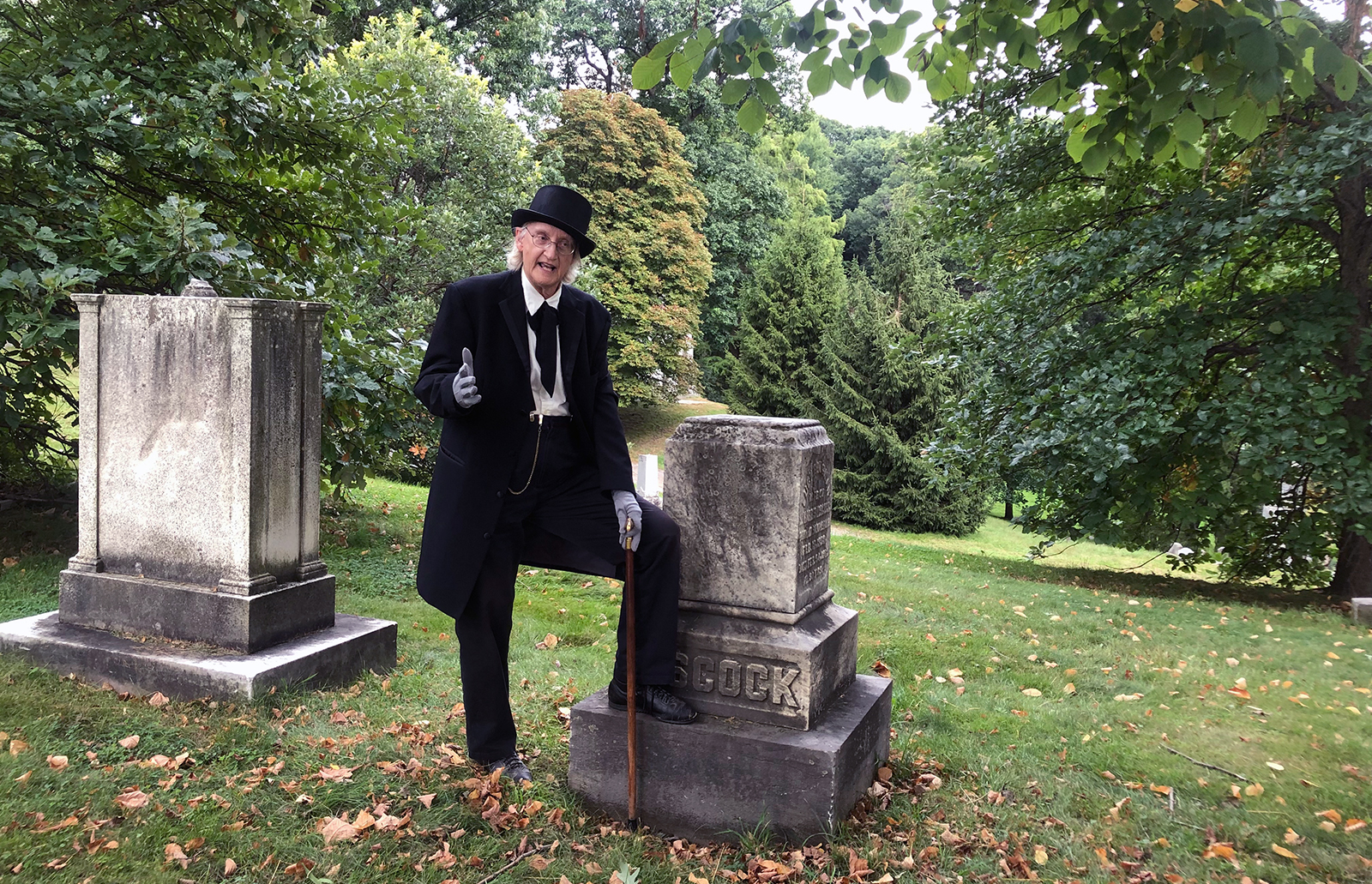

From the vantage point of a bench perched on a small, tree-covered hill overlooking Oakwood Cemetery’s Mortuary Chapel, this place’s peaceful nature obscures its role as a resting place for 60,000+ souls. A warm breeze rustles the leaves above and mixes with the sporadic sounds of scurrying woodland critters and the dull whine of traffic on closeby Interstate 81. Nearby sits a sculpted lion that rests atop a young man below, guarding him. The sunken eyes and pronounced rib cage of the Haggerty lion seem to suggest a message, a metaphor, a meaning. But the lion and the leaves remind those who sit on this bench that although cemeteries serve as the final resting place for the dead, they are designed to be experienced by the living.
And in the past year, more of the living have sought out these spaces to escape a virus that delivered a lot of death, forced the globe indoors for months, and then pushed them back outside to find some relief. “People got sick and tired of walking through the same city park,” says Rick Naylor, president of the Historic Oakwood Cemetery Preservation Association (HOCPA). “So, more and more people were showing up at Oakwood Cemetery. We’d be there working and volunteering, so we would stop, introduce ourselves, and offer them a map.”
Oakwood, described as a rural cemetery, was built just for that kind of purpose and highlights the history of how our collective expectations of what cemeteries should be and do have changed. During the mid-19th century, city cemeteries began to overfill, creating health problems and unsightliness. “The graveyard, not cemetery, graveyard, was to be next to the meeting house at the town church in the middle of the town,” Naylor says. “Go all the way back to the late 1600s of the pilgrims and puritans, the burial grounds were put right in the middle of town right next to the church, the meeting place, the place of worship.” But as villages and cities grew, available space dwindled, and citizens sought to remove the health hazard in their midst and reimagined the space for burying their loved ones. Several cultural forces informed that reimagining, including a growing appreciation for natural space — something only the wealthy could afford and something prized as industrialization — turned cities into grimy, dirty messes.
“There were no such things in the Victorian age as city parks,” Naylor says. “The commoner had no place to go. People that had wealth, had a summer home in the lake up in the Adirondacks. They had the means to get away.”
The rural cemetery movement sought to address both of these problems by moving cemeteries out of the cities and designing them so that common people could go out and enjoy a bit of nature. “Back then, it was all dirt, streets, and, you know, animals and whatnot. Summertime was atrocious in the city,” says Susanne Greenhagen, one of the five HOCPA tour guides and the association’s historian. “So they said well why don't we make a park like area, you know today we'd call it green space, a park like area where our dearly departed can rest there and we can come visit them on the weekend.” That green space arrived for Syracusans when the cemetery opened in 1859. Designed by landscape architect Howard Daniels, it encompasses 160 acres and serves as the last of Daniels’ 15 rural cemeteries. Beyond the landscape of the space, the tombs themselves also started to reflect the societal shift in regards to death. Mausoleums became living rooms for the dead, places where relatives could come on a sunny Sunday, share a picnic, and hang out.
Today, these spaces attract visitors not only for the nature, architecture, and art of the tombs, but also the history they hold. “I don't think there's any boring history,” says Greenhagen.”There’s only boring history teachers that made it so dull that people just came to dislike it.”
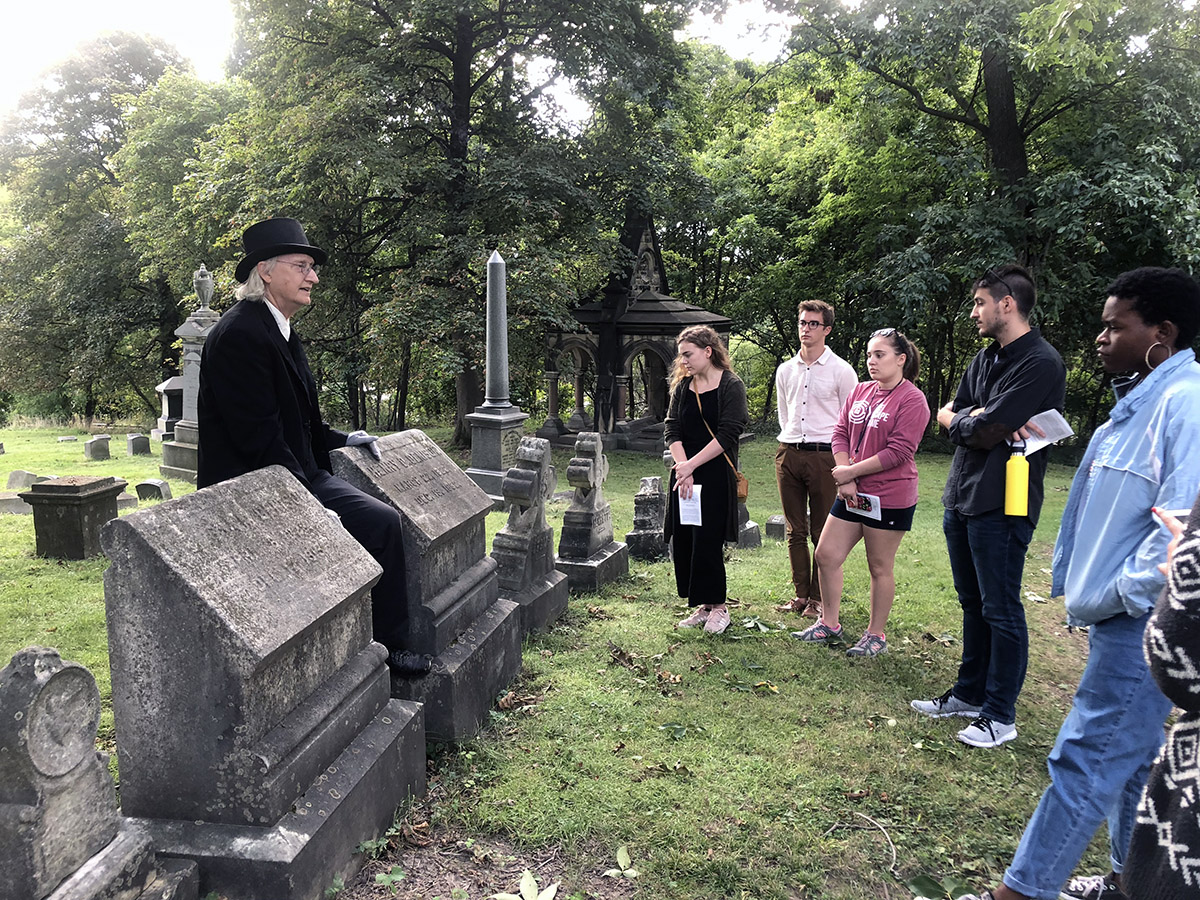
Dressed as a Victorian-era undertaker, Susanne Greenhagen serves as one of the five tour guides for the Historic Oakwood Cemetery Preservation Association (HOCPA) and as the organization’s historian. Photo by Melissa Chessher.
Oakwood holds some of the city’s most celebrated politicians, writers, entrepreneurs, philanthropists, criminals, and inventors such as Charles F. Brannock. Born in Syracuse in 1903, Brannock worked at his father’s shoe store during summer breaks from Syracuse University. That summer work inspired him to create the Brannock device, the steel foot-measuring instrument used at shoe stores to this day. There’s also Cornelius Longstreet, who rests in one of the cemetery’s more eye-catching monuments, a towering pyramid. Longstreet, who was born in Onondaga Valley in 1814, is credited with creating mass-production clothing and as the first to ship “ready-made” clothing to the West Coast. And Melville Clark, born in 1883, invented the Clark Irish Harp. Several innovators helped build Syracuse’s reputation as “Typewriter City.” In fact, at the start of the 20th century, half of all typewriters were produced in Syracuse. The Smith Brothers took the patented invention of the double keyed typewriter designed by Alexander T. Brown and mass produced it. The Smith family’s commanding mausoleum greets those entering from Comstock Avenue. Oakwood also serves as the resting place of Anna Short Harrington, one of the models used to promote the corporate brand “Aunt Jemima.” Born in South Carolina in 1897, Harrington eventually found herself working as a cook at Syracuse University before being discovered by Quaker Oats. She earned enough money to buy a 22-bedroom house, which she divided and rented out as a boarding house in the 15th Ward of Syracuse, a famous and thriving African-American community destroyed for the construction of Interstate 81.
The grounds attest to Syracuse’s identity as a refugee city and its role in the abolition movement and the Underground Railroad. The remains of freedom seekers and abolitionists that worked on the Underground Railroad, such as Rev. Jermain Wesley Loguen, Congressman Amos Granger, and Samuel Joseph May, rest here. Loguen was a freedom seeker who escaped slavery in Tennessee and settled in Syracuse. A prominent figure on the Underground Railroad, he ran a depot that helped see other freedom seekers to safety in Canada. He even played an instrumental in the Jerry Rescue, which saw the successful rescue and escape of a freedom seeker, who called himself Jerry, who was a victim of the Fugitive Slave Law and arrested with the intent to be taken back to North Carolina. On the same day as Jerry’s arrest, an organized crowd formed at the police station holding Jerry and used the confusion to spirit Jerry away from Syracuse and into Canada. This incredible act is memorialized with a monument downtown in Clinton Square. And Edmonia Highgate, the daughter of freedom seekers who was born in Syracuse, worked with the American Missionary Association to help educate and teach Black women, men, and children how to read in the south. She died at a young age due to a botched abortion. She can be found next to the Teall plot, resting next to her brother.
“[Oakwood] is an outdoor museum, let’s face it,” says Greenhagen. “The movers and shakers, the forefathers, the foremothers of Syracuse and it’s vicinity, they’re here.”
Sometimes the shifting ground and landscaping in the cemetery reveals old grave markers obscured by the tumults of nature and time.
With more people coming to visit, Naylor says there’s been a greater interest in the history and architecture of Oakwood. Growing up, Naylor would go to the cemetery several times a year with family to care for deceased relatives’ gravestones. He and his cousin played in the cemetery, and Naylor became fascinated by the architecture. He began studying early Puritan gravestone designs, and by age 10, his parents would drop him off at a cemetery for the day with snacks, a canteen full of Kool-Aid, vellum paper, and a brown or black jumbo crayon during their family vacations in New England. For hours, he would make rubbings of the tombstones. His parents warned him against talking to strangers, but as a kid fascinated with tombstones, he became a bit of a spectacle. While he often encountered others making grave rubbings in the cemetery, most of them were closer in age to his grandparents, and they often wanted to talk. “I never met a stranger, but I made a whole bunch of friends,” Naylor says. “We corresponded via letter back and forth, and then it occurred to me that we were pen pals.” Today, he points out, if you run into a fellow cemetery lurker, you continue those conversations on Facebook.
Like Naylor, David Sloane, a professor in the Sol Price School of Public Policy at the University of Southern California, possesses a longstanding fascination with cemeteries. He teaches courses in urban planning, policy, history, and community health planning and grew up in Oakwood. His father took over as superintendent of the cemetery in 1953, and Sloane spent his youth wandering through and marveling at nature and gorgeous monuments surrounding him. Those experiences proved powerful, informing his future studies. While pursuing his doctorate at Syracuse University, he decided to write his dissertation about the historical importance of cemeteries in the United States and published his first book, The Last Great Necessity: Cemeteries in American History, in 1991 as one of the first comprehensive histories of the American cemetery.
But not all Oakwood fans have lifelong experiences with the cemetery. Jodi Upton, for example, didn’t grow up in Syracuse, but the Syracuse University professor says an encounter with Naylor while walking her dogs there prompted her to become involved with a range of efforts connected to it. First, she joined the Oakwood Crypt Keepers, a group of more than 50 volunteers who preserve and clean up the cemetery. “Rick happened to be standing next to the chapel, and we ended up chatting for 45 minutes,” Upton says. “He has so many stories and knows so much about the cemetery that I was like, ‘This is something I want to be involved with and want to help with.’”
With a long career in data journalism, Upton is also working on a project to digitize Oakwood’s vast burial records. She partnered with the Syracuse University Libraries to attempt to preserve the deteriorating historical records from the 19th century. The group, which received a $5,000 grant from the Central New York Library Resources Council, strives to restore records containing vital information such as cause of death, the time between death and burial, and funeral home information. Records allow for researchers to understand, for example, patterns of disease and malnutrition and the potential race and ethnicity of the deceased from funeral home records.
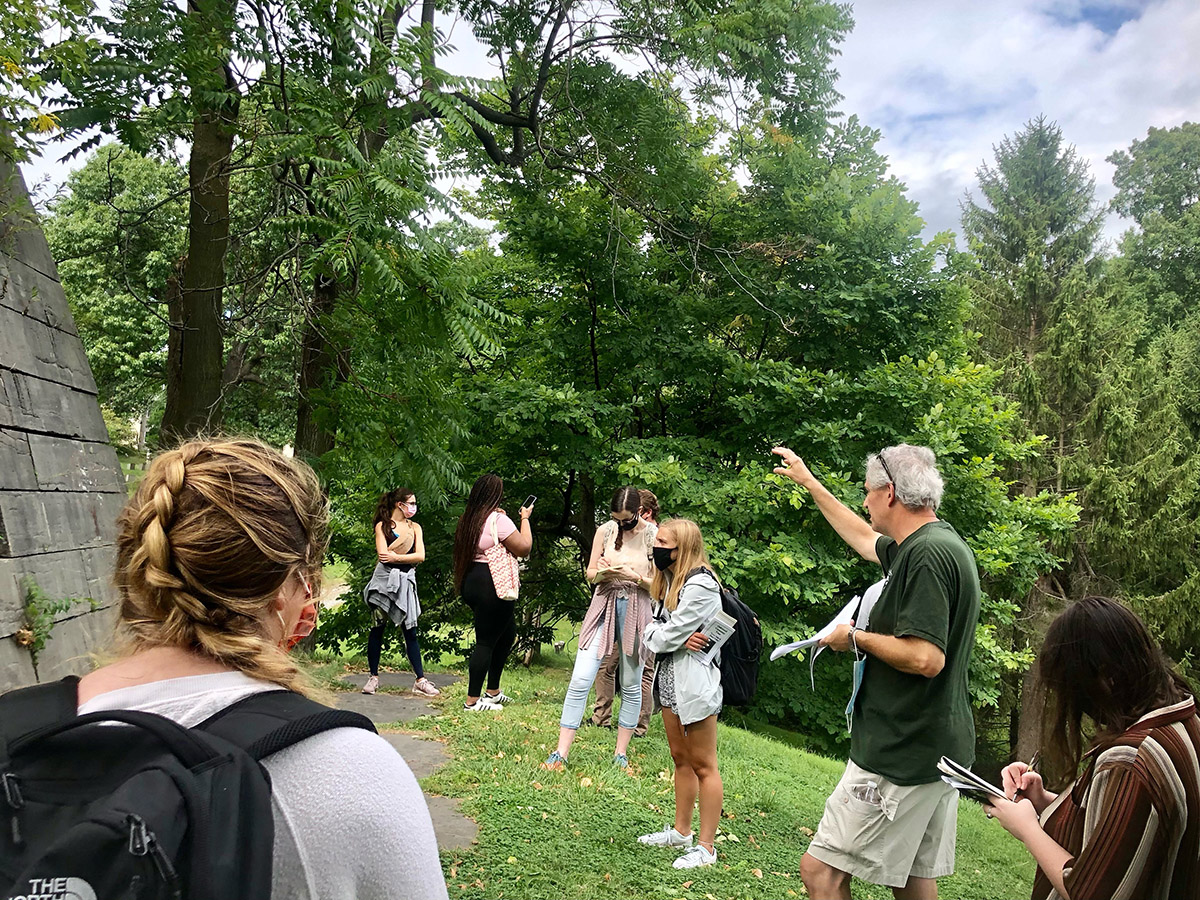
HOCPA President Rick Naylor, who also gives tours, grew up visiting the cemetery, playing on the grounds with cousins, tending to family graves, and admiring the architecture of Oakwood. Photo by Melissa Chessher.
To preserve and protect the landscape and monuments, the Syracuse community can join Upton and the Crypt Keepers by clearing brush and researching the cemetery. The job of maintaining individual headstones and monuments belongs to the deceased’s family, but volunteers help with general maintenance. “For some of it, there's so much overgrowth that they actually need a chainsaw,” Upton says. “Because 100 years ago somebody planted a lilac bush that has now completely grown over the graves, and you can't see them.”
Upton encourages local college students to get involved in preservation efforts or even just enjoy the cemetery. She says that she’s noticed an increase in college students spending sunny afternoons in the cemetery. However, she remarked that students often don’t look completely comfortable in the space. “They always look like they're slightly guilty, like they're not quite sure if they should be there,” she says. “The idea of telling your friends that, ‘Yeah, I walk through the cemetery every day,’ just seems a little odd.” Upton adds that awkwardness connects to our cultural relationship with the dead. “Places like Oakwood are meant to be enjoyed by the living,” she says, “And not every cemetery is built that way.”
HOCPA board member Diane Medvitz specializes in helping the living by connecting people with long-lost deceased relatives who are buried in Oakwood. With the help of a friend, Medvitz has photographed and documented every recorded person buried in Oakwood Cemetery through 2018 and posted them on Find a Grave. After documenting the gravestones and uploading obituary information to Find a Grave, Medvitz connects to a global audience interested in Oakwood. She has received messages from all over the world — Australia, and Germany, Canada, Sweden, Italy — from genealogy enthusiasts searching for long-lost relatives. However, the project, which started in 2010, has experienced some challenges. Only about 70% of the names in Oakwood — or about 58-59,000 people, in Medvitz’s estimation — have markers, making the project unending. “We discover more all the time,” Medvitz says. She explains that sometimes the shifting ground and landscaping in the cemetery reveals old grave markers obscured by the tumults of nature and time.
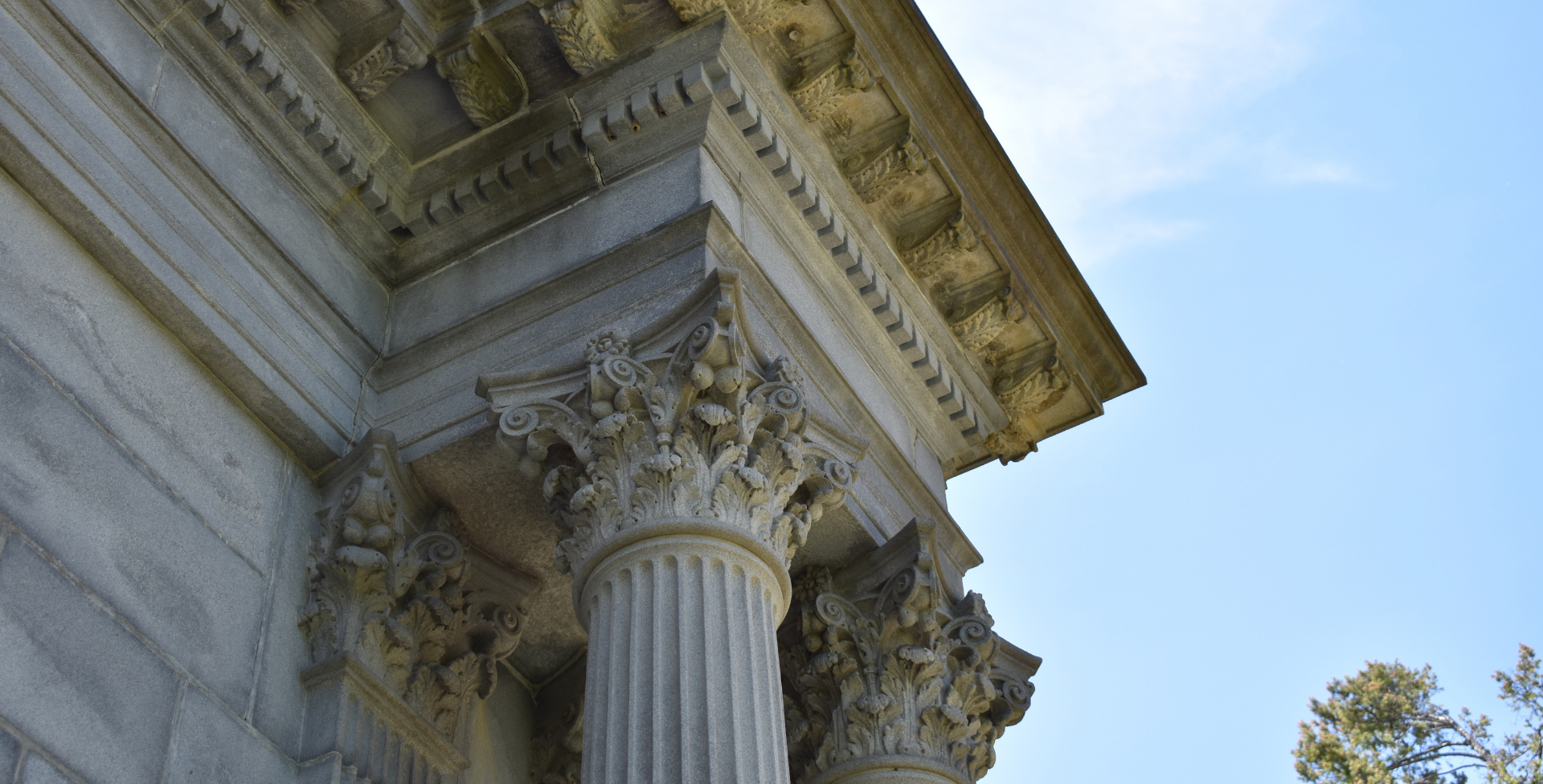
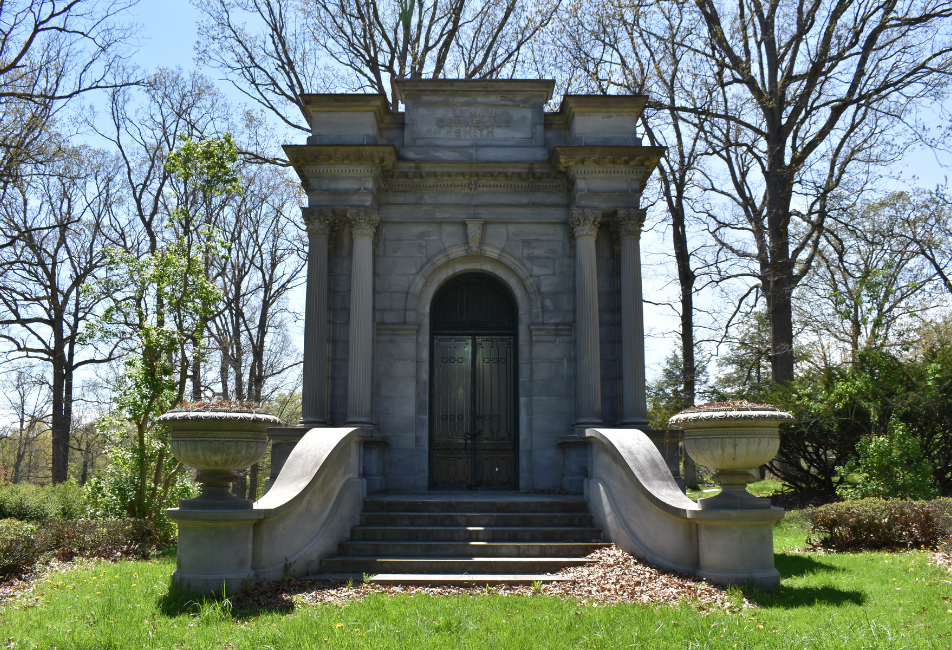
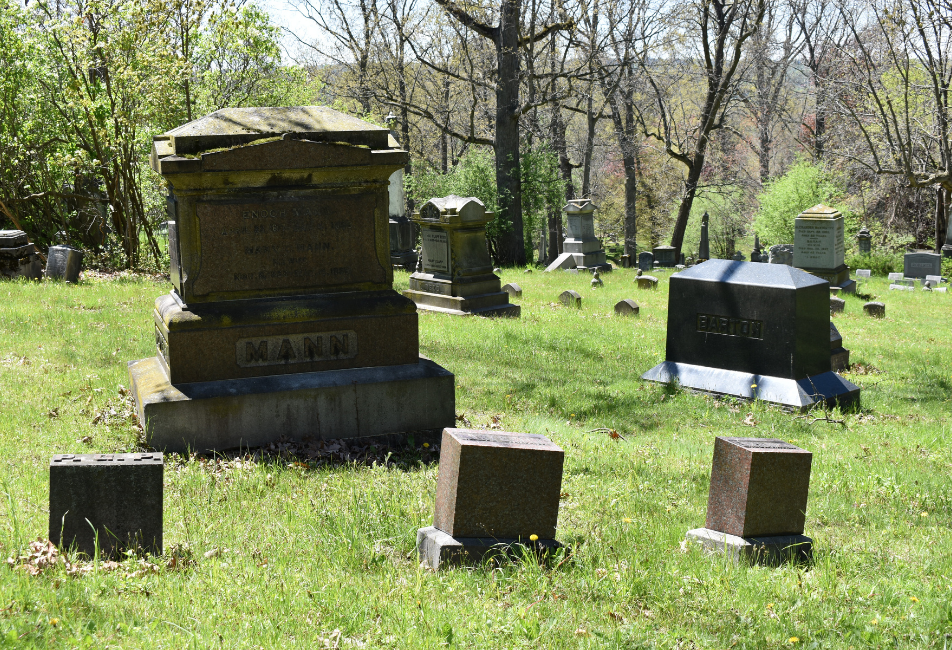
“[Oakwood] is an outdoor museum, let’s face it,” says tour guide Greenhagen. “The movers and shakers, the forefathers, the foremothers of Syracuse and its vicinity, they’re here.” Photos by Emily Johnson.
Medvitz also serves as a tour guide through HOCPA. When giving tours, she has shared some of the lesser-known history of Syracuse like the story of the Wilkinson family. John Wilkinson, the man who named the City of Syracuse and the president of the Syracuse and Utica Railroad, and his family are buried in section 17, plot 1. Many college students are familiar with the monument, a canopy tomb where they lounge in hammocks attached to its pillars and sunbathe on the neighboring flat tomb. Wilkinson’s son, Alfred, married Charlotte Coffin May Wilkinson, the daughter of Rev. Samuel May, a famous pastor, abolitionist, and suffragist who worked with Elizabeth Cady Stanton and Susan B. Anthony. Because of his connection to the Wilkinson family, he is buried in their plot. Alfred Wilkinson, Jr., the son of Alfred and Charlotte May Wilkinson, later fell in love with and became engaged to Varina Anne Davis, the daughter of Confederacy President Jefferson Davis. The daughter of the Confederacy had become engaged to the grandson of an abolitionist. However, they never married; Jefferson Davis’s wife did not approve of the union. Alfred Wilkinson, Jr. is also buried in the Wilkinson family plot.
As a “living historian,” Greenhagen dons historical costumes, assuming the personas of important figures in Syracuse history. Her most popular tour, “Live Oaks and Dead Folks,” lasts about 45 minutes to an hour. Greenhagen explains that while the tour follows the gravesites of some of the most interesting people buried in the cemetery, it’s the tour guide’s task to bring life to the stories. For example, through her living history tours, she’s adopted the identities of Margaret Olivia Slocum Sage, the maid-turned-wife of multi-millionaire Russell Sage, and Harriet Schwartz, a woman instrumental in getting the Soldiers and Sailors Monument erected in Clinton Square.
“People really get into it,” Greenhagen says. “They almost accept the fact that that's who you are. I'm sitting next to Olivia Slocum Sage’s gravesite, but it doesn't faze them that she is buried there and I'm sitting there. No, I am Olivia, and it's just amazing.” Greenhagen describes the cemetery as an “outdoor museum,” and she hopes students will use the cemetery as a historical resource.
“Most kids from my era always thought of cemeteries as morbid and scary and not a place you want to go,” she says. Before Covid-19, Greenhagen gave her tour each semester for almost a decade to a writing class from Syracuse University and routinely entertained two busloads of students from West Genesee High School. “I would take them on a tour around the cemetery, getting them over this morbidity and scariness and introducing the cemetery as a resource,” she says.
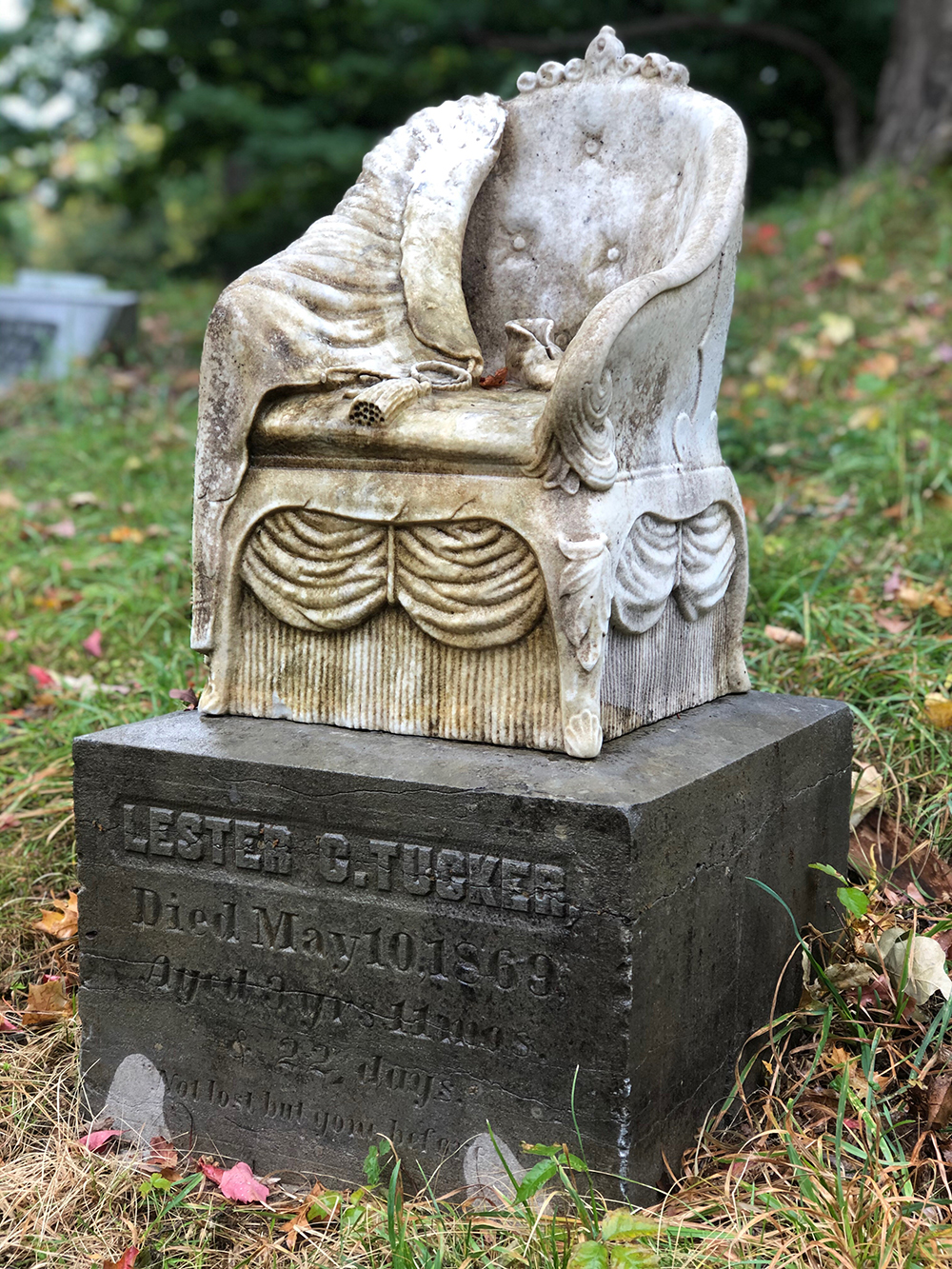
Known for its orb activity, the “Devil’s Chair” serves as the most popular stop on The Ghost Trail, a tour that 2.25 miles and features stories of ghost legends and haunts of the cemetery. Photo by Melissa Chessher.
Beyond the history, the architecture, and the stories, the cemetery’s trees also attract visitors. And another major goal for the future of Oakwood is to plant more trees. On Labor Day 1998, a massive storm obliterated about 1,000 trees in Oakwood, leaving decaying stumps, fallen limbs, and craters. Prior to the storm, the canopy of trees was contiguous. Wherever a visitor traveled, a tree’s branches offered shade. Today, some sections of the cemetery feature only a scattering of trees. But members of HOCPA want to restore Oakwood to its original beauty. Hilary Donohue, a board member of HOCPA who heads a tree committee, also hopes to reintroduce native species into the cemetery, as many non-native species, such as the Bald Cypress and European Beech, were planted when the cemetery was first designed.
Native trees in the cemetery include the White Oak, a common North American shade tree with gray to light tan bark, and the Cucumber Magnolia, a towering tree native to the Northeast that can be spotted behind the Oakwood Chapel. Rarer trees include the Dawn Redwood, a species native to North America, Greenland, and Asia. Before scientists identified fossilized remains of the species, they believed it had been extinct for 20 million years. However, a Chinese forester found an enormous Dawn Redwood in the Sichuan province of China in 1944. Today, the tree can be found in the United States and is only second to the panda as a conservation icon in China. The tree is the smallest of the three redwood species, but it typically grows to stand between 50 to 60 feet. And some redwoods can grow to over 160 feet with a seven-foot diameter trunk. Other foreign trees in the cemetery include the Austrian Pine, Katsura, and Norway Maple.
The cemetery’s tree trail offers tree-lovers a guide to the area’s best examples. Syracuse University senior Cristian Toellner, along with Joseph DiStefano and Jonnell Robinson, created the tree trail as part of an internship. Donohue also helped create the trail. “Over the years, I've been walking through the cemetery,” Donohue, a 2010 SU graduate, says. “There are a number of trees I’ve been paying attention to and watching through the seasons. So, I mapped a route around the cemetery that seemed walkable for the average person and identified 20 trees. Some are native to the cemetery and common, but there are some that are less common.” The informational map takes visitors on a loop around the cemetery.
HOCPA board members hope initiatives such as the tree trail project will encourage members of the Syracuse community to enjoy the cemetery. The park-like nature of the cemetery attracts history buffs, dog walkers, and nature enthusiasts alike. Through their restoration efforts, HOCPA also hopes to recruit more volunteers to preserve the future of the cemetery. “The cemetery can go in one of two directions,” Greenhagen says. “One direction is in to disrepair. It can just degrade. And the other direction is to improve, to become more relevant to the community, to become more important as a resource. And that’s our main goal — to preserve and protect Oakwood Cemetery for future generations.”

Our pursuit of outdoor joy is remiss without the acknowledgement of the occupation of unceded Indigenous land. We are students and journalists working, writing, and living on the land of the Haudenosaunee Confederacy, comprising the Six Nations made up of the Mohawk, Onondaga, Oneida, Cayuga, Seneca, and Tuscarora nations. However, acknowledgement is not enough. Read More.